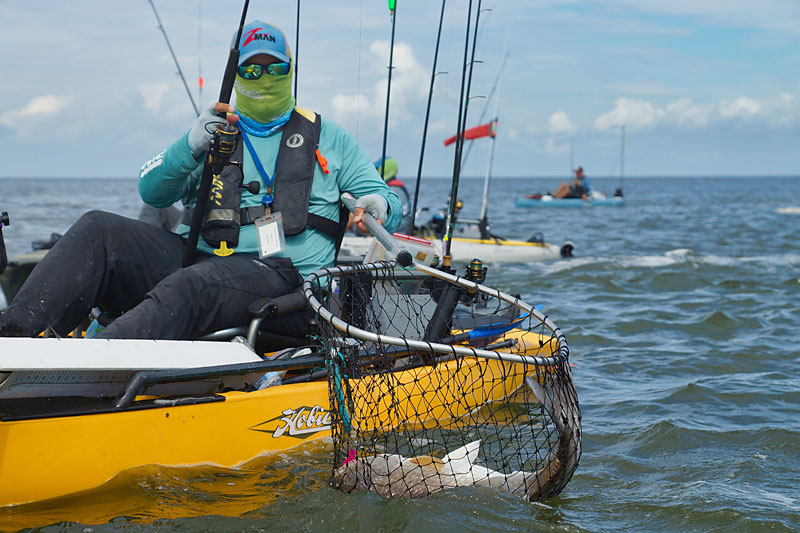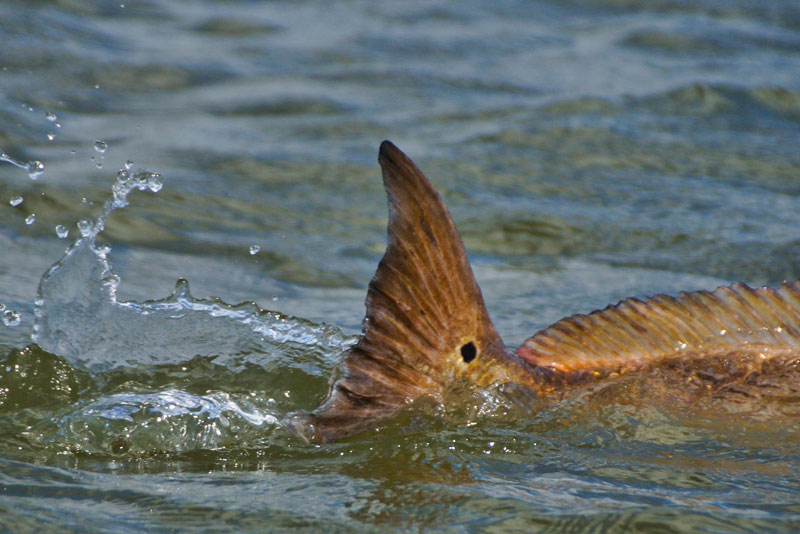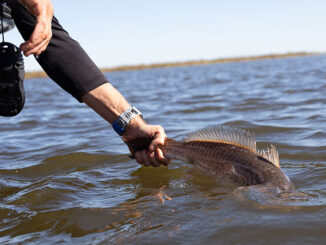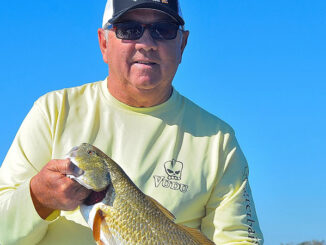
Take precautions, make your trip a success
Kayak fishing can be a bit strenuous. Whether pedaling or paddling, the exertion can quickly cause your body to overheat. However, with a little planning, you can safely and comfortably fish at the peak of the hot Louisiana summer and catch some great fish, too.
Kayaks offer no protection from the elements. Be it rain, cold, heat or glaring sun, you are exposed and need to plan accordingly. Overexertion and sunburn are big, potential problems with summer kayak fishing. To avoid both, planning your trips for early mornings, late evenings and even at night makes them safer, comfortable and more productive. Comfort and safety are foremost; however, the fish are also more active at these cooler times of the day.
Dress properly. Kayaks sit low to the water, and the sun’s glare/reflection is enhanced. If any skin is exposed, sunscreen is a necessity. It is messy and sweats off, and it must be regularly reapplied in order to be effective. However, long pants in a good, technical fabric, a long-sleeve shirt and other items offer UPF sun protection without the mess. Many kayakers think wearing short pants and short sleeves is more comfortable in summer, but they are wrong. Specialty fabrics wick moisture and actually have cooling properties. Lightweight gloves and socks also keep hands and feet protected from the sun. Do not overlook your face and head. A good hat or cap, especially a ventilated, wide-brimmed hat, and a quality face shield works wonders. Quality, polarized sunglasses should always be worn.
Preparation
Hydration is a key to staying healthy and comfortable on hot days. If you know you are going fishing in a day or so, pre-plan and increase your water intake beforehand. On the day of the trip, make sure to drink plenty of water. Mixing in a couple of sports drinks also helps to add electrolytes to your system and is better than drinking sports drinks alone.
Night trips are also good, especially on small ponds or areas where you are not likely to encounter powerboats in the dark. Make sure you have the required hand-held flashlight for signaling other boaters to your presence. An additional, 360-degree white light is good to have for added visibility. Bug spray is always a good idea. The temperatures will be cooler, and you likely will have the area to yourself.
As always, reliable communication equipment should be carried. Cell phones are not always reliable, and it is good to also carry a quality, waterproof hand-held VHF radio. Leave a float plan with a member of your family or a friend to let them know where you are going and your expected return time. This can save valuable time by narrowing an area to start looking for you if needed.
Plan of attack
You’ve done the proper preparation, now let’s get to the fishing.
Plan to start your fishing as early as possible. Suitable fishing light can be as early as 5 a.m. That means you can fish for 5 hours and be off the water by 10 a.m. while the heat is still bearable. Mornings are cooler, and before the sun gets up high, fish are generally more active. This is also a great time for some topwater action. Whether you’re bass fishing or chasing speckled trout and redfish, work topwater lures close to any cover, structure or the shoreline and prepare for an explosion. If the cover is heavy, weedless topwaters like frogs and sunfish work equally well in fresh and saltwater.
Early mornings, fish are more scattered. Make sure to cover the water all the way around the kayak. However, as the sun starts to rise, they tend to seek cover and shade. Shade comes in the form of logs, docks, grass beds, trees, reeds and overhead branches. Look deep into the grass beds and cast farther back under docks and anywhere cover provides shade.
Once the sun is up, consider punching heavy cover with a weedless setup. The same rigs you use for bass also catch redfish.
One mistake often made fishing summer evenings is heading out too early; 3 p.m. is still the doldrums, and all you’ll do is sweat and make empty casts. Wait until about 5 p.m.; it will be cooling off some, and the fish will get active again. This still allows several hours of quality fishing before dark.
Bull reds
Summer is also a great time for catching bull redfish as they school in and near deep, coastal passes. Live bait, dead bait and scented soft plastics like Gulp! work great on bulls, which are typically not finicky.

A depth finder is great help in locating large schools of bull redfish that travel together through the passes; this is much more productive than blindly picking a spot. Keep a lure out and slowly troll along, keeping one eye on your screen and the other peeled for any surface activity. Of course, the trolled lure may get hit without you seeing a thing. However, once you locate a school, the action can get fast and furious. These fish are hard fighters and provide great sport in a kayak.
Bull reds are not great table fare, and although Louisiana regulations allow you to keep one longer than 27 inches per day, once landed, the best practice is to spend some time making sure the fish is properly revived and released. A lip-grip is a great way to slowly pull the fish alongside the kayak to get some water moving over its gills. If you don’t have one, hold the fish by the tail, and move it back and forth in the water. As the fish revives, you will feel it get stronger and know when it is good for the release.
The weather is hot, but so is the fishing. Adjust your fishing times and spend the hottest part of the day indoors in air conditioned comfort. By taking a few precautions, you can have some great summer fishing during the most-comfortable parts of the day or night.


